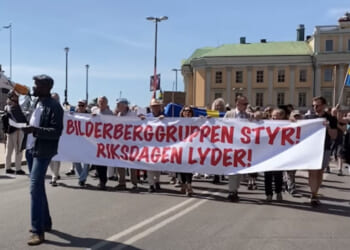By Phil Giraldi
There is an often-cited cliché whenever historians gather that asserts that when two nations go to war, the history books produced in the aftermath will be written by the victors, meaning that truth about what actually occurred will be somewhat elusive. The war currently involving Russia and Ukraine is somewhat different in that the outcome, at least on the battlefield, is somewhat predictable as Vladimir Putin has obtained most of his territorial demands and his army would appear to have overwhelming superiority over that of Ukraine.
Click the Link Below to Listen to the Audio of this Article
The war began with some clearly defined objectives coming from both sides, with Russia demanding that the Russophone Donbass region of Ukraine be granted in fact the autonomy that they had been promised in the Minsk agreements of 2014-2015 but which had been denied by Kiev with Ukraine’s central government’s encouraging its only partly controlled militias to attack Donbass and other Russian majority regions (oblasts), allegedly killing as many as 8,000 ethnic Russians.
Russia also demanded that discussions of possible Ukrainian membership in NATO be halted as Moscow—already lied to about NATO expansion into the former Soviet Union in the 1990s—would consider such a move to be a major security threat and a blatant act of war.
It should be observed by future historians that the Ukraine crisis began in 2014 when the country’s Russia-friendly government of Viktor Yanukovych was overthrown in a major covert action by the United States, which had been trying for several years and at a cost of $5 billion, to remove the democratically elected incumbent and replaced him with someone friendly to the United States and the NATO alliance.
Since that time of burgeoning hostility between Moscow and Kiev, fed by NATO, Ukraine has, for its part, portrayed itself as the victim of a expansionistic Russia, and it, too, now has demands, namely that all territories currently occupied by Russia must be returned as well as Crimea, which is the major Russian naval port on the Black Sea. It has been restored as an integral part of Russia since a popular referendum approved that move, after the break-up of the Soviet Union, also in 2014.
Crimea, in fact, had, prior to that point, been part of Russia since it was acquired by Catherine the Great in the 18th century, being transferred to Ukraine only for administrative reasons in 1956 by Nikita Khruschev. Ukraine also reserved its right to join NATO, which attracted support from countries like Germany, Poland, the Baltic States, Britain and France, as well as the United States.
Up until now, the war has been fought—and presumably prolonged—due to weapons, intelligence and money coming from NATO’s Europeans and, most importantly, from the United States, intended to keep President Volodymyr Zelensky in the game. Zelensky, for his part, knows that, if he does not continue the fighting and claim to be in it to regain lost territory, he will likely be removed from office—and a dead man very shortly thereafter.
But, unfortunately for him, there is new leadership in Washington, and it now appears that the Donald Trump administration is tired of the game, which it rightly sees as no benefit to U.S. interests, unlike the Biden administration, which involved itself in the war “to weaken Russia.”
Trump and his foreign policy team have been seeking to act as intermediaries to arrange some kind of diplomatically negotiated ceasefire that would satisfy at least some of the demands of both parties and will allow the United States to disengage so it can focus military resources more effectively on China and the Middle East. Given that pressure, to no one’s surprise, on May 2, Tammy Bruce, the State Department spokesman, announced that the United States would no longer continue to act as an intermediary to come to some kind of agreement and would leave it up to the two belligerents to come to some kind of arrangement. She said:
We will continue to help, but we will no longer fly around the world as mediators in meetings. Now it is up to the two sides. The time has come when they must present and develop concrete ideas on how to end this conflict. It will be up to them.
Nevertheless, the game is not over yet. The United States had set itself up as a peacemaker, negotiating both with Ukraine and Russia. Part of the problem was that Trump, whose knowledge of the situation might be described as variable, continued to fire off his thoughts combined with threats confusing everyone involved in the talks.
For example, on April 17, Trump characteristically described his role:
If for some reason, one of the two parties makes it very difficult, we’re just going to say, you’re foolish. You’re fools, you’re horrible people, and we’re going to just take a pass.
On the same day, at a meeting in Paris, Secretary of State Marco Rubio presented something like that same ultimatum to French, British, German and Ukrainian officials at a meeting intended to discuss a possible peace plan:
We need to figure out … within a matter of days, whether this is do-able in the short term. If it’s not, then I think we’re just going to move on.
The United States was openly preparing to bail out and then pull the plug, which is what took place on May 2. Ironically, at the Paris meeting, the peace plan in one-page written form as proposed by Trump and Rubio had been presented to Ukraine and the Europeans.
As predicted, it compromised on a number of issues to make it acceptable, but it became a dead letter when it was earlier rejected utterly by Zelensky on April 23 over the future status of Crimea and any role with NATO.
Zelensky said:
Ukraine will not legally recognize the occupation of Crimea. It’s our territory, the territory of the people of Ukraine. There is nothing to discuss here.
The second point was that Ukraine’s constitution commits it to pursuing membership in NATO. Zelensky has thus refused to give up Ukraine’s NATO ambitions.
So, in spite of the initial push from Trump and Rubio, the talk of a peace plan has now appeared to hit a wall, possibly because Moscow now sees the NATO Europeans as stirring up the pot. Vladimir Putin’s National Security Advisor Nikolay Patrushev recently stated that, Ukraine negotiations notwithstanding:
[The West is] deploying their military machine against Russia and becoming delirious with nuclear apocalypse scenarios. For a second consecutive year, NATO is conducting exercises at our borders at a scale unseen in decades. They are training for conducting a broad offensive from Vilnius to Odessa, seizing the Kaliningrad Region [a Russian exclave], imposing a naval blockade in the Baltic and the Black Seas, and executing preventive strikes on the staging locations of Russian nuclear deterrence forces.
Beyond that existential threat, as feared by the Kremlin, neither the Russians nor the Ukrainians are willing to budge from their differences that started the war in the first place which could have been negotiable before the fighting even began.
Both sides now consider their differences to be vital national security interests, though it is Ukraine that must make the major concessions while Russia is largely content with the status quo with one exception, i.e. the economic sanctions that Europe and the United States have placed to damage the Russian economy and its world role.
Resolving the issue of Crimea and taking NATO out of a manageable peace agreement is likely to be achievable, particularly if sanctions on Russia can be canceled or suspended as a quid pro quo, something the Europeans appear to so far be unwilling to do.
In an interesting new twist, Trump has, since starting the negotiations, several times floated a suggestion that would seem to be outside the box, namely that Ukraine partly compensate the United States for the $350 billion in aid already provided. This might be accomplished by licensing Ukraine’s reportedly significant mineral resources (consisting of oil, gas and aluminum) to U.S.-controlled investor companies to provide an incentive to Ukraine to take some risks to advance the peace talks that are still technically going on.
Possibly to keep Washington as an active ally in spite of its walking out of negotiations, Ukraine has now agreed to a deal giving the United States control over a share of its future revenue from natural resources, a long-awaited agreement, and a concession that Kiev clearly hopes will clear the way for continued U.S. support without having to make further concessions that would be politically difficult for Zelensky.
The announcement came late on April 30, two days before the U.S. withdrawal from the negotiations, confirming that the agreement had finally been signed after months of negotiations—including at least one known explosive Oval Office confrontation—to end the fighting.
A joint U.S.-controlled investment fund between the countries gives Washington and Trump a stake in what happens to Ukraine, while also avoiding the need to give Kiev a blank check to try to resist the Russian invasion. The agreement might lead to more consequential talks on a possible peace treaty with Russia, though that is not a given, as the two issues are not linked. That being said, most critics of it in the United States plausibly make the case that the agreement is a non-starter and is little more than an excuse to keep talking.
Nevertheless, there will be issues. First of all, Russia will not be pleased, and there are definite risks of escalation with Moscow if the final economic package includes a U.S. security presence in Ukraine.
Indeed, one of the most dangerous and counter-productive additions to the new “minerals deal” is an apparent provision that any U.S .military assistance shipped to Ukraine will go into the joint investment fund on the plus-side of the U.S. ledger. In other words, this “breakthrough” has opened the door for the United States to return to the Joe Biden policy of endless weapons supplied to a nearly defeated Ukraine … with a promise to “pay you back” once minerals are extracted from what remains of Ukrainian soil.
This would inevitably serve to prolong the war that Trump claims he wants to end.
Critics of the agreement also observe that the implementation could be complicated. Some of the “mineral deposits” are in the areas that have been occupied by the Russian army, and the fighting will have to stop before the product can actually be mined. Others question whether or not Ukraine even possesses the minerals it claims to be sitting on.
Also, Ukraine’s parliament still has to ratify the agreement, which will probably happen soon, and there is not yet any infrastructure in Washington to carry out the U.S. role in the investment fund that will manage the project.
So, is it all just a bit of spitting in the wind that will only sustain the status quo? Maybe, and it also could be designed largely to give Trump something that he can call a “victory.”
Thus, one attempt at a peace agreement has apparently died, but there is still a glimmer of life in spite of the expressed desire on the part of the Trump administration to disengage from a war that it now appears to want no part of.
The minerals agreement might be viewed as irrelevant and, in any event, it would only sustain the current fighting temporarily. Strategically, serious peace talks still need to have the Europeans come around to the point of view that there is little to be gained by continuing to arm Ukraine to “weaken Russia.”
At that point, realistically speaking, both Moscow and Kiev might easily be convinced by the U.S. and Europeans combined to lay down weapons and come to an understanding that they might easily have arrived at three years ago. In that light, one must hope that reason will prevail soon and put an end to the bloodshed.
Philip Giraldi is a former CIA counter-terrorism specialist and military intelligence officer and a columnist and television commentator. He is also the executive director of the Council for the National Interest. See more from Giraldi at the website of the Unz Review.
(function() {
var zergnet = document.createElement(‘script’);
zergnet.type=”text/javascript”; zergnet.async = true;
zergnet.src = (document.location.protocol == “https:” ? “https:” : “http:”) + ‘//www.zergnet.com/zerg.js?id=88892’;
var znscr = document.getElementsByTagName(‘script’)[0];
znscr.parentNode.insertBefore(zergnet, znscr);
})();



























